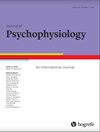Facial Reactivity and Attentional Processing of Facial Expressions and Gaze Direction
IF 0.9
4区 心理学
Q4 NEUROSCIENCES
引用次数: 1
Abstract
Abstract. Patterns of facial reactivity and attentional allocation to emotional facial expressions, and how these are moderated by gaze direction, are not clearly established. Among a sample of undergraduate university students, aged between 17 and 22 years (76% female), corrugator and zygomatic reactivity, as measured by facial electromyography, and attention allocation, as measured by the startle reflex and startle-elicited N100, was examined while viewing happy, neutral, angry and fearful facial expressions, which were presented at either 0- or 30-degree gaze. Results indicated typically observed facial mimicry to happy faces but, unexpectedly, “smiling” facial responses to fearful, and to a lesser extent, angry faces. This facial reactivity was not influenced by gaze direction. Furthermore, emotional facial expressions did not elicit increased attentional allocation. Likewise, matched facial expressions did not elicit increased attentional allocation. Rather, happy and fearful faces with direct (0°) gaze elicited increased controlled attentional allocation, and averted (30°) gaze faces, regardless of emotional expression, elicited preferential, early cortical processing. These findings suggest typical facial mimicry to happy faces, but unexpected facial reactivity to angry and fearful faces, perhaps due to an attempt to regulate social bonds during threat perception. Findings also suggest a divergence in controlled versus preferential, early cortical attentional processing for direct compared to averted gaze faces. These findings relate to young, mostly female, adults attending university. The experiment should be repeated with a larger sample drawn from the general community, with a broader age range and gender balance, and with a stimulus set with validated subjective valence and arousal ratings. This can reduce Type II error and establish normative patterns of facial reactivity and attentional processing of emotional facial expressions with different gaze directions.面部反应性与面部表情和注视方向的注意处理
摘要面部反应的模式和对情绪面部表情的注意分配,以及这些是如何被凝视方向所调节的,还没有明确确立。在17至22岁的大学生样本中(76%为女性),当以0度或30度凝视的方式观看快乐、中性、愤怒和恐惧的面部表情时,研究人员通过面部肌电图测量瓦楞纸和颧骨的反应性,以及通过惊吓反射和惊吓引发的N100测量注意力分配。结果表明,通常观察到的面部模仿是快乐的脸,但出乎意料的是,“微笑”的面部反应是恐惧的,在较小程度上是愤怒的脸。这种面部反应不受凝视方向的影响。此外,情绪化的面部表情并没有引起注意力分配的增加。同样,匹配的面部表情也不会引起注意力分配的增加。相反,直视(0°)的快乐和恐惧面孔引起了更多的控制注意力分配,而回避(30°)凝视的面孔,无论情绪表达如何,都引起了优先的早期皮层处理。这些发现表明,典型的面部模仿是对快乐的脸,但意外的面部反应是对愤怒和恐惧的脸,这可能是由于在感知威胁时试图调节社会关系。研究结果还表明,与避开凝视的面孔相比,直接凝视的面孔的早期皮层注意力加工在受控与优先方面存在差异。这些发现与上大学的年轻成年人(主要是女性)有关。这个实验应该在更大的样本中重复,从一般社区中抽取,年龄范围和性别平衡更大,刺激集具有有效的主观效价和唤醒评级。这可以减少II型错误,并建立不同凝视方向下情绪面部表情的面部反应和注意加工的规范模式。
本文章由计算机程序翻译,如有差异,请以英文原文为准。
求助全文
约1分钟内获得全文
求助全文
来源期刊

Journal of Psychophysiology
医学-神经科学
CiteScore
2.60
自引率
7.70%
发文量
25
审稿时长
>12 weeks
期刊介绍:
The Journal of Psychophysiology is an international periodical that presents original research in all fields employing psychophysiological measures on human subjects. Contributions are published from psychology, physiology, clinical psychology, psychiatry, neurosciences, and pharmacology. Communications on new psychophysiological methods are presented as well. Space is also allocated for letters to the editor and book reviews. Occasional special issues are devoted to important current issues in psychophysiology.
 求助内容:
求助内容: 应助结果提醒方式:
应助结果提醒方式:


